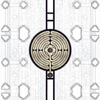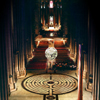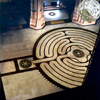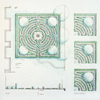
Labyrinth
PERHAPS MORE ANCIENT THAN THE
MEGALITHS, more ancient than the pyramids, more ancient than
the concept of Platonic solids, is the concept of the labyrinth.
Reputedly built for the first time by Daedalus, the first
architect, it is inexorably tied by the thread of Ariadne
to the long line of archetypal memory that is itself the memory
of civilization, and to the primordial myths that have shaped
the western imagination. Image of creation, path of the spiritual
seeker, image of chaos and of order, of process and of construct,
the labyrinth is also an image of the self. It is both prison
and way of liberation. If the rhythm of its dance marks the
cycles of time, the unraveling of the thread marks time's
irreversibility.
The design of the labyrinth
is also based on the same basic numbers 1, 2, 3 and 7 characteristic
of the Platonic solids. Its concept, therefore, integrates
it with the design of The Millennium Sphere and that
of the rite within the cathedral architecture.
In the last decade or so, the
ancient practice of labyrinth-walking has enjoyed a revival,
and is now often a feature of retreats, making its inclusion
in the proposed rite natural and easy.
The interior labyrinth
would be located in the axis of the nave, closer to the narthex,
following the tradition of medieval cathedrals such as Chartres
and Amiens. At St. John the Divine, the ideal location is
across the sacred geometry bay, i.e., the 4th bay in the nave.
The labyrinth would be inlaid
in the floor and made of slate of contrasting colors matching
those of the existing floor. Its outer diameter would be 45',
its path distributing itself along seven rings centered on
the fifth medallion, that of Samaria on the existing Pilgrim's
Pavement of the cathedral floor. Being the 5th in position
in the succession of eight within this the nave proper, it
stands for the dominant of the octave, and therefore for the
optimism and hope of the pilgrim who has reached his goal.
This medallion is a representation
of water and a well evoking the words spoken by Jesus to the
Samaritan woman: "Whosoever drinketh of the water I shall
give shall never thirst." It is a fitting symbol of the
spiritual knowledge that all pilgrims thirst for, particularly
those undertaking the labyrinth walk. It also symbolizes the
refreshment at the end of the journey and an invitation to
look upward towards the "heavenly Jerusalem" and
its symbol, The Millennium Sphere.
The entrance to the labyrinth
would take place on the 4th medallion, the Cana medallion.
Again, that fourth position is significant, for in the notes
of the octave it corresponds to fa, a note of hesitation
and slight sadness, indicative of the minor key, and appropriate
to describe the apprehension of the pilgrims at the outset
of their journey. The medallion shows a cup of grapes surrounded
by water pots, recalling the miracle at the wedding feast
at Cana, marking the beginning of the ministry of Jesus. The
text indicates: "The beginning of miracles did Jesus
in Cana of Galilee." It would also therefore indicate
the beginning of the way of the pilgrim. |
[click
on images to view larger version]

Partial nave plan with labyrinth

view animated Ad Quadratum generation [swf file]

Nave interior looking East

Nave interior view
|
Outside,
right across, in the axis of the bay, in the south side garden
along the wall of the cathedral, would be laid the garden
labyrinth marking the site of the buried capsule.
The external path would be square
to indicate its relation to Earth. In sacred geometry the
square stands for the Earth and the circle for the Heavens.
A small rose garden at the center with a small water fountain/bird
bath surrounded by benches accommodating 6 to 8 people, would
echo the center medallion of the well of Samaria in the nave
labyrinth. A small arbor at the entrance, to "defend"
the entrance, would add a touch of awe and apprehension to
be induced on approaching the labyrinth and be a counterpart
to the "fa" note of the interior labyrinth at the
"Cana" medallion. The flowers would be chosen to
change colors with the seasons of the liturgical year. The
four colors marking the 8 seasons of the Proper of the Seasons
are white, red, green and violet. To them would be added the
popular colors of the seasons such as green and red for Christmas
in addition to liturgical white. |

Garden labyrinth |
